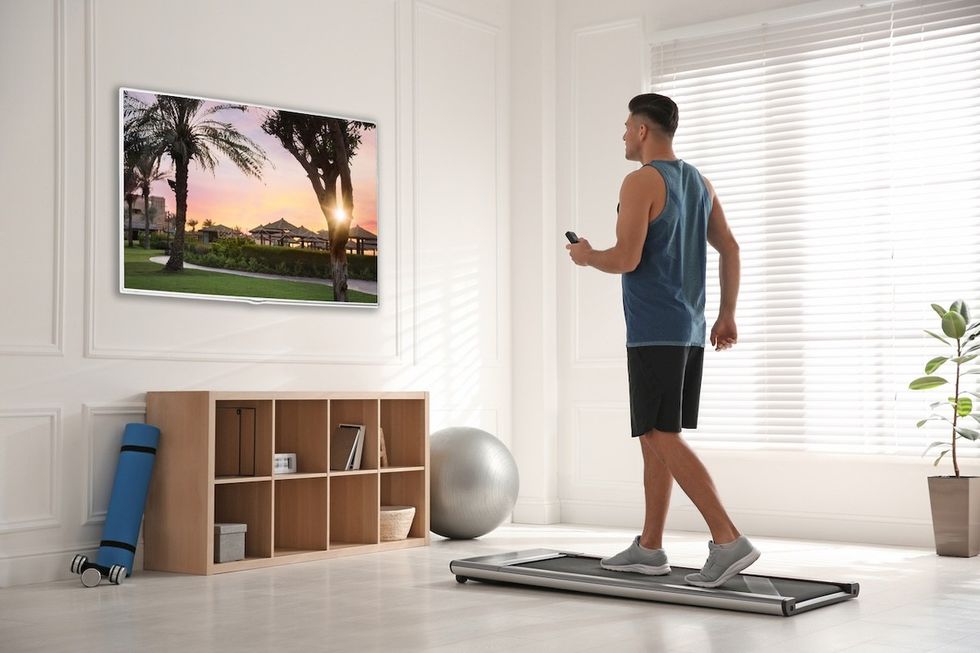Walking is a fantastic way to stay active, improve your health, boost your mood, and even live longer—especially if you set your step count ambitiously high at 10,000 steps per day. Of course, one of the easiest ways to achieve this is to lace up your sneakers and head outside for a stroll. However, there are plenty of things that can stand between you and the great outdoors, inclement weather included.
When that happens, it’s a good idea to have a backup plan that lets you get your steps in, all without needing to step outside. You won’t need to physically go far to make the most of your workout, experts say. With these seven simple tips, you can reach your goals and reap their health benefits all from the comfort of your own home.
RELATED: This Simple Exercise Is the Equivalent of 10,000 Steps, and It Takes Just 30 Minutes.
1. Try “reward pairing.”
iStock
“Reward pairing” is the practice of coupling something you don’t particularly like to do with something you view as a reward. By bundling the two—and only enjoying the reward while doing the chore—you can help create more motivation to do the less desirable thing on your to-do list.
Michael Betts, a personal trainer and the director of TRAINFITNESS, says this could help you turn passive screen time into active movement when you pair your favorite show and indoor walking or marching.
“Most shows and movies are 30-60 minutes long, perfect for logging a good amount of steps. Walking during just two episodes of your favorite show can add 4,000-6,000 steps to your day,” he tells Best Life.
One of the easiest ways to do this is by investing in a treadmill or walking pad.
“Modern walking pads are quiet, foldable and can slide under furniture when not in use,” adds Betts. “Even walking at 1.5 to 2 mph will get you steps while you stay productive.”
3. Turn your stairs into a workout.
iStock
Walking up and down stairs can not only increase your step count but can also add to the physical rigor of your exercise.
Cheng-Han Chen, MD, board-certified interventional cardiologist and medical director of the Structural Heart Program at MemorialCare Saddleback Medical Center, previously shared with Best Life that climbing stairs gives you roughly three times as much exercise as the same amount of time walking briskly on the ground.
“That’s because not only are you moving your body, you’re moving it against gravity, and you’re essentially pushing yourself up and out. You are also building your muscles in your lower body, strengthening your core and your lower back,” he explained.
Don’t have stairs in your house? No problem.
Aerobic steps—yes, the plastic platforms that were all the rage during the ’80s and ’90s—can help you get your steps in. If you’re not sure how to make the most of it, look for a workout video to follow along to. Or, simply set a goal and get those reps in—no movement is wrong as long as it’s safe!
RELATED: 5 Best Indoor Walking Workouts for Weight Loss, Experts Say.
3. Take your phone calls on the go.
Shutterstock
Jerome Draculan, an NASM-certified personal trainer working with StrengthshopUSA.com, suggests taking your phone calls on the go. You can do this on your walking pad, of course, but he also recommends walking around the kitchen island or from room to room.
“Choose a path that you want to walk repeatedly throughout your home, from the living room to the kitchen, the bathroom to the bedroom,” he advises.
Betts agrees that phone calls offer a great opportunity to walk indoors: “Walking while talking feels natural and flies by. A 30 minute call can easily get you 2,000-3,000 steps.”
4. Get into cozy cardio.
Shutterstock
If you have a walking pad or a treadmill, getting into “cozy cardio” can help motivate you to get to 10,000 steps.
The trend started on TikTok and involves setting a meditative-like space for your walking workout—think ambient lighting, scented candles, and feel-good music.
“When something is comfortable and you feel good during and after, you’re more likely to do it and stick with it! I think it makes cardio feel more like self-care (which it is) and less like a punishment,” Rachel Lovitt, CPT, holistic movement coach, previously shared with Best Life.
5. Use your chores as exercise.

Much of the time, we strive for efficiency in doing our chores. However, Draculan suggests that you can turn these activities into a step challenge by breaking your work up into piecemeal parts. For instance, once you’ve folded your laundry in a central location, you can walk each individual item to where it belongs.
You can also strap on some ankle or wrist weights while doing your chores to increase the intensity of your workouts.
RELATED: “Rucking” Is the New All-Ages Fitness Trend That Can Make You Look and Feel Younger.
6. Take a detour.

Especially when you’re first getting started with your new walking routine, don’t underestimate the power of increasing your step count in small increments. Amanda Grimm, a certified running coach and personal trainer at We Run, says you can do this in your home by taking the long route whenever possible.
“Instead of using the nearest bathroom, resolve to go to the one furthest away in your house,” suggests Grimm. “If you live in a single-story home, you could take a loop around the house before heading to the toilet. These small detours throughout the day can quickly add up to a significant boost to your step count.”
7. Set a movement alarm.
Shutterstock
When you work from home, it’s all too easy for the day to get away from you and for your steps to end up on the back burner. Grimm recommends setting an alarm for various times throughout the day to remind you to take a short walk around your house.
“You could do laps in your hallway, around furniture or, for extra credit, up and down the stairs for an extra challenge,” Grimm suggests. “These quick bursts of movement will significantly increase your step count, and can also help to feel more alert too.”





